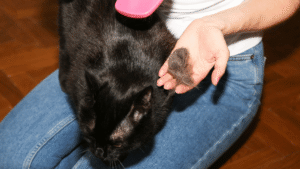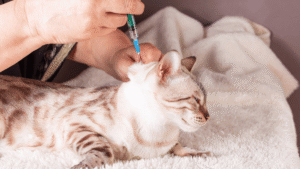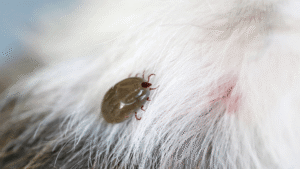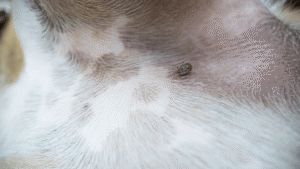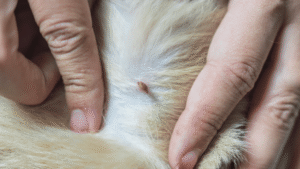When dealing with “cat hair loss from fleas”, it’s crucial to act quickly to prevent further damage. Fleas can cause more than just itching; they can lead to severe hair loss and skin irritation if not addressed. This guide will help you understand the best ways to manage flea-induced hair loss, while using the healthy cat weight chart to ensure your cat is at an ideal weight for overall health. Follow these game-changing tips to restore your cat’s fur and maintain a healthy weight for your furry friend!
Understanding Cat Hair Loss from Fleas: Why It Happens
Cat flea hair loss is a frequent problem which causes fur thinning and bald regions to appear. Fleas drink your cat’s blood, making your cat feel itchy and uncomfortable. All this licking, biting and scratching causes hair to fall out.
The good cat weight chart may be used to assist your cat in staying within the ideal weight for cats as it recovers from a flea infestation.
Fleas themselves can also cause secondary infections if left untreated, and so it’s really crucial to be right on top of flea treatments as well as keeping an eye on your cat’s health and keeping them at a healthy weight.
Cat weight by age is an important factor in gauging the general wellbeing of your pet. Kittens, adolescents, and adult cats all have different weight control needs. For example, an adult cat’s healthy weight is going to be very different to a kitten or a senior cat.
Regularly tracking your cat’s weight using a cat weight chart helps your cat reach an ideal weight for cats, which improves her health.
It should be noted that obese cats may make treating a flea infestation more difficult. Obese cats may have trouble grooming themselves and this may also contribute to the risk of flea-induced hair loss.
If you want to help your cat get to a healthy weight, you’ll need to consult your vet and begin a “healthy cat diet” to keep up with your pet’s weight and overall health.
Flea Treatment for Cats: Stop the Infestation Before It Gets Worse
Effective treatment is the first step when dealing with “cat hair loss from fleas”. When your cat is matted it is important not to let it get out of control in order to avoid additional damage to the fur and skin. And being aware of what cat weight management looks like can help us give them the proper dosage.
First, fill out your arsenal with spot-on treatments, which are convenient to apply and provide extended protection. These therapies are highly effective for killing fleas and preventing more weight issues in cats caused by flea health problems in cats!
And, remember, flea prevention products can work even better when your cat is a healthy weight. This allows the items to absorb well without impeding their health.
Oral flea drugs are another potential cure for flea hair loss. Your cat eats these and they then flow through your cat’s blood, and when fleas bite, they die.
Be sure to consult with your vet on the ideal weight for cats so you know the proper dosage to administer. Cats who are obese or overweight may require higher dosage for effectiveness.
Flea collars are also good for long term prevention. These collars emit chemicals that kill fleas upon contact and protect your cat for six months. Still, you should ensure that the collar fits well as the weight of a cat determines how well a collar will stay put.
Well, if your cat has weight issues, make sure you add a balanced healthy cat diet for flea treatments. The proper diet can also help keep in check your cat’s weight and make them more active and healthier.
During the period of weight loss, it is important to monitor its weight to prevent obesity-related disorders.
Flea Prevention for Cats: Keep Fleas from Reappearing
Now that you’ve dealt with “cat hair loss from fleas” the next critical thing is you will want your cat to be flea-free. As important as treating the problem is ensuring past and future problems are met with. Here are some critical flea prevention tactics to keep fleas from coming back:
Normal Flea Control Measures
You can never avoid prevention, especially in terms of fleas and hair loss. The best way to prevent fleas is by using flea collars, topical treatments, and oral medicines on a regular basis. They offer a protective layer to keep your cat flea free and their weight at a health level.
For instance, spot-on treatments offer long lasting protection for weeks. Always follow the advice of your vet relative to the most effective flea control for your cat, given her age, size and weight issues in cats.
Tips on Grooming for Flea Control
Grooming is one of the best methods to recognize a flea infestation early. Remove any fleas & flea dirt with a fine-toothed flea comb. Grooming your cat regularly not only helps you catch “cat hair loss from fleas” early but is great for your cat’s skin overall.
Washing your cat with shampoos that kill fleas can also eradicate the fleas. Just keep in mind, it is a lot easier to groom your cat when he is in perfect weight from a balanced diet – but who will remain more cooperative and nimble.
Occasionally Clean Your Home Atmosphere
Fleas not only live on your cat; they infest your home. Flea eggs and larvae can survive in carpets, upholstery and bedding. To prevent new infestations in your home, clean and vacuum your house often, paying special attention to where your cat likes to spend time.
You might want to try some home flea spray to kill remaining eggs and larvae. It’s worth remembering that a clean environment is important not just for controlling fleas, but for your cat’s all-round health, and for helping him keep weight under control.
Flea Infestation and Hair Loss: How Fleas Can Lead to Serious Skin Issues
While “cat hair loss from fleas” is concerning, it’s essential to understand the broader skin problems fleas can cause. Fleas are more than just an itchy nuisance—they can lead to severe skin irritation, infections, and other health issues.
Flea Bites and Skin Irritation in Cats
Flea bites break the skin and introduce saliva that causes allergic reactions, resulting in skin irritation. As your cat scratches, bites, or licks the affected area, it leads to further hair loss and even open wounds.
This constant irritation disrupts the skin’s ability to heal, leading to painful sores and scabs. It’s critical to treat the fleas as soon as you notice symptoms and monitor your cat’s weight during recovery, as a stressed, uncomfortable cat may struggle to maintain a healthy weight.
The Risk of Secondary Infections Due to Flea-Related Wounds
When fleas cause open wounds, there’s a risk of secondary infections. Bacteria can enter through the bites, leading to abscesses or more serious skin conditions.
If left untreated, these infections can affect your cat’s overall health and cause further hair loss and discomfort. Prompt flea treatment and a healthy cat diet can help your cat recover quickly and prevent long-term health issues.
Natural Remedies for Fleas in Cats: Safe and Gentle Solutions
If you’re more of a naturalist, there are many mild ways to treating fleas that won’t harm your cat or affect their healthy weight. These are some natural and effective remedies:
Flea Killing Essential Oils
Lavender and eucalyptus are two essential oils that fleas do not like. Add a couple of diluted essential oil drops to water and use as a spray on your cat’s hair.
Not only that, but these oils act as natural flea deterrent as well as soothers, great for cats who have gained weight due to frazzled nerves. Always dilute the oils appropriately and be sure to ask your vet, as there are some oils that are toxic to cats if not diluted or used properly.
Apple Cider Vinegar
One of the best remedies for fleas is the apple cider vinegar solution. Mix vinegar with water and apply it to your cat’s fur with a spray bottle.
Using apple cider vinegar wash can help balance the skin’s natural pH, making it inhospitable to pesky fleas. It’s an easy, non-toxic defense against fleas and a great way to keep your cat’s skin and weight healthy.
DIY Flea Treatment Sprays
Using vinegar will help reduce the fleas in your house, but they\’re not going to go without a fight. Mix together 1 cup of water, 1 cup of witch hazel and a little bit of an essential oil (like lavender or cedarwood). Spray this product on your kitty’s body, but not on her face, so it does not irritate the eyes.
This home remedy is very useful. A simple way to prevent fleas is to feed one spoon of brewer’s yeast to your cat daily, considering its weight and age and it is also called as one of the natural flea killer for cats.
How to Spot Fleas on Cats: Quick Detection Tips for Pet Owners
Discovering “cat hair loss from fleas” early is the key to minimizing the harm and discomfort your cat is experiencing. Discovering fleas early can be vital in helping recover your cat from flea-induced hair loss and skin lesions. Here’s how to spot the signs:
Signs of Fleas on Cats
Scratching is the most common symptom of cat hair loss from fleas. Fleas induce extreme itchiness that leads to your cat scratching, biting, or licking a single area so much that they lose hair.
This then results in the loss of fur in cats with the condition. To check for fleas, search for flea dirt — black specks on your cat’s fur.
When these are smeared with a wet paper towel they will appear red-brown, indicating the fleas’ presence. Also, you may be able to see the physical fleas on your dog in areas, such as at the nape of the neck or under the tail.
If not treated, cat hair loss from fleas can lead to even bigger patches of baldness, particularly around the most inflamed spots. Flea-induced hair loss is a signal that you ought to take action to treat the fleas and help your cat heal.
Flea Removal Tips
You can also get rid of the fleas thoroughly with the help of flea comb. This fine-toothed comb is effective in removing fleas, flea dirt, and eggs from your cat’s hair.
Concentrate efforts in places where the fleas hide; behind the ears and on the neck. Soapy water can be used to drown fleas after each combing. A flea shampoo may also help in cleaning your cat’s fur well removing any remaining fleas.
If you are dealing with “cat hair loss from fleas”, flea combing and monitoring your pet’s weight maintenance will play key roles in treating the infestation and recovery.
Managing Flea Bites and Hair Loss: Treating Flea-Induced Skin Damage
Another thing to remember with cat hair loss from fleas is once the hair loss has taken place, we need to focus on the skin damage brought about by infestation of fleas. Here’s how you can help relieve flea bites and encourage healing:
How to Manage Flea Bites
Flea bites are itchy and sore so when your cat scratches and licks these open sores, it damages your cat’s skin and this leads to hair loss in cats.
To soothe flea bites, wash the affected area with warm soapy water to keep it clean and free from debris. Dab on a gentle balm such as aloe vera gel to help reduce inflammation and speed healing. If bites are severe or you notice signs of infection, consult your vet for further care.
Overweight cats or those that are not as mobile can have more issues with flea bites because they might not be able to groom those areas by themselves. So now it’s even more important for your cat to be a healthy weight to help them in their recovery.
Healing Hair Loss from Fleas
“Cat hair loss from fleas” such as from constant scratching and biting may take a long time to mend. Help hair to regrow by ensuring a complete and well balanced all round healthy cat diet which includes high levels of vital nutrients such as omega-3 fatty acids and biotin. These nutrients promote hair growth and assist in quicker healing of your cat’s skin.
If your cat is a senior cat, regrowth can be even more slow, and so you have to be particularly vigilant in monitoring their weight control. Older cats are also more likely to suffer weight loss that can reduce the ability to fight back against flea infestations and flea-induced hair loss (in other words, the level of infestation is serious).
Flea Control Products for Cats
To avoid any future flea infestations (and subsequent cat hair loss from fleas) apply the correct flea prevention products. Spot-on treatments, flea collars, and oral prevention treatments to keep fleas from coming back are all good preventative methods as well. Make sure to always pick specific products that fit your cat’s weight size, age and weight problem.
Using these products as directed, in combination with regular checking of your cat’s healthy weight, will mean that they remain free from fleas and their coat remains shiny.
Table: Comparison of Top Flea Treatments for Cats
| Treatment Type | Effectiveness | Duration of Protection | Side Effects | Cost |
| Spot-on Treatments |
Very High |
4-6 weeks |
Minimal |
Moderate |
| Oral Medications |
High |
1 month |
Possible vomiting |
High |
| Flea Collars |
High |
6 months |
Skin irritation |
Low |
| Natural Remedies |
Moderate |
Temporary |
None |
Low |
Conclusion: Take Control of Flea Hair Loss Before It Gets Worse
In conclusion, cat hair loss from fleas can be managed effectively with timely detection and treatment. Tackling flea infestations early ensures that your cat avoids long-term skin damage and excessive hair loss. Regular use of flea prevention products, along with a consistent healthy cat diet and grooming routine, will help maintain your cat’s fur and health.
Remember, preventing flea infestations is key to ensuring your cat remains flea-free and happy. Don’t wait for the problem to get worse—act fast to restore your cat’s health and fur.
We encourage you to share your experiences in the comments section below. Have questions about flea prevention or “cat hair loss from fleas”? Feel free to ask, and let’s help your cat stay healthy and happy!
FAQs
Q1: How can I tell if my cat has fleas?
The first symptoms of cat hair loss from fleas are excessive itching, hair loss, and flea dirt (tiny black speckles covering your cat’s fur). Either of these signs calls for a close inspection of your cat with the use of a flea comb.
Use a flea comb to help you locate and remove fleas and check for flea dirt, which is often a telltale that your pet is infested. Early recognition is crucial to avoid additional hair loss and cutaneous damage.
Q2: Can fleas make a cat’s hair permanently fall out?
While cat hair loss from fleas is generally not long term, an undiagnosed infestation can make a pet scratch so much that he or she causes significant and permanent damage to their sensitive skin.
If she keeps scratching and biting the sores, you could find that you have to treat her for a skin problem, including bald patches and scabs, for quite some time. Urgent cure and prevention is necessary to prevent the situation from being permanent.
Q3: What can I do to make sure my cat does not have fleas?
To avoid “cat hair loss from fleas”, apply a flea prevention products for instance flea collars, topical treatments for a flea, or oral vervain weekly. It is also important to keep your cat’s living environment clean: vacuum carpets, launder bedding, and apply flea sprays to the home.
Regular grooming also aids in early detection of fleas, and removes any flea dirt or eggs from your cat’s coat. Keeping your cat at a steady, healthy weight through a healthy diet also helps them fight off fleas and heal faster.
Q4: Can all cats be treated with natural flea remedies?
Home remedies, such as lavender oil and apple cider vinegar, can be successful flea control treatments, but not all cats respond to these remedies. As with any natural remedy, discuss the use of immune boosting supplements with your vet, particularly for kittens, senior cats, or cats with pre-existing conditions or immune system issues.
Natural flea treatments are milder but it is very important to make sure that they are secure for your kitty otherwise you could end up with more problems, for example, cat hair loss from fleas.
Q5: How long does it take for a cat’s hair to grow back after flea loss?
Your cat’s coat will generally grow back in 4-6 weeks after flea-related hair loss, depending on the extent of hair loss and the impact of the treatments. When given good care, a healthy cat diet, and good regular flea prevention, your cat’s fur will regrow back to its full health. But take it easy, some cats can take longer (especially older cats or those with health complications).


